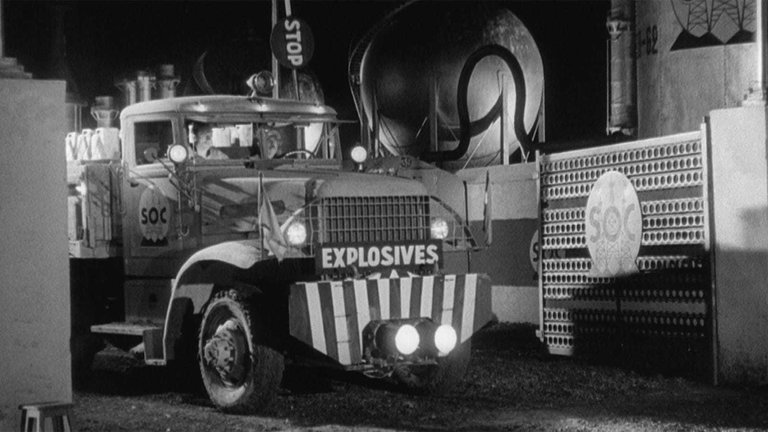Film Review: The Wages of Fear ( Le Salaire de la peur, 1953)

Desperate situations require desperate measures. One such situation serves as basic premise for The Wages of Fear, 1953 adventure thriller directed by Henri-Georges Clouzot, one of the grand classics of 1950s French and world cinema.
The film is an adaptation of eponymous 1950 novel by George Arnaud, partially inspired by author’s own experiences in South America. Plot begins in Las Pideras, fictional town in unnamed South American country. It is a remote place, more or less accessible only by a airstrip and controlled by US-owned South Oil Company. Among locals there is a number of expats, mostly Europeans who came there in a vain hope that would get job by the company, but are instead forced to spend most of the time in local bars because they can’t afford air ticket back. One of those is Mario (played by Yves Montand), young Corsican who hides his despair by cocky attitude that brought him attention of beautiful local barmaid Linda (played by Vera Clouzot). Things begin to change with an arrival of Jo (played by Charles Vanel), French gangster on the run who initially pretends to be rich and becomes some sort of friend and mentor to Mario. This is followed by the news of one of company’s oil wells being on fire that could be extinguished only by explosion that requires large amounts of nitroglycerine. Company needs volunteers, preferably expendable non-unionised expats, to drive the dangerous volatile cargo over hundreds of miles of dangerous roads. Mario and Jo are hired and promised 2000 US$ if they survive the ordeal. They begin journey followed by truck crewed by fellow expats Bimba (played by Peter van de Eyck) and Luigi (played by Folco Lulli).
The Wages of Fear was one of the most successful films of its time. It was immediately hailed as masterpiece by critics, awarded both by Palm d’Or and Golden Bear and became a major box office hit in native France. This triumph can be explained by the film’s modernity or, more precisely, ability to provide content which looks like a standard of 21st Century action cinema, but was something quite innovative in early 1950s. Modernity can be seen in an unusually realistic approach, evident in its multilingual dialogue and content like nudity and references to urination, something that was unimaginable in Holywood at the time due to puritanical restrictions of the Hays Code. The Wages of Fear actually did have serious problem with censorship in USA, being cut for 20 minutes, although such cuts can be also explained by the film’s subversive political undertones. Film explicitly condemns film that explicitly condemns capitalism and US imperialism. The portrayal of a US corporation as the villain exploiting the protagonists' desperation can be interpreted as a comment on post-WW2 Europe's weakness and dependence on American superpower.
Henri-Georges Clouzot's direction in the film is masterful, not only in his ability to convincigly pass locations of Southern France as exotic and dangerous South America. Clouzot stages at least four gripping suspenseful scenes that rival Hitchcock's mastery. The absence of music enhances the tension, keeping audiences fully engaged[. Additionally, the diverse international castdelivers strong performances that enrich the storytelling. Yves Montand, who was at the time known mostly as a singer, shines in his first serious dramatic role and same can be said of the veteran Charles Vanel.[
While The Wages of Fear excels in many aspects, its excessive length, particularly due to prolonged introductory scenes, can be seen as a drawback. Furthermore, the character of Linda, played by Clouzot's wife Vera, may appear overly glamorous for the film's setting, slightly detracting from its realism. The film's bleak ending, contrasting Hollywood conventions with its tragic conclusion, has been criticized for feeling rushed and melodramatic. Despite this critique, it serves as a poignant antithesis to traditional happy endings prevalent in mainstream cinema.
The Wages of Fear was remade twice by Hollywood – in 1958 as Violent Road, film directed by Howard W. Koch and in 1977 as Sorcerer, film directed by William Friedkin. Eponymous French remake directed by Julien Leclerq and produced by Netflix, is scheduled for release in March 2024.
RATING: 8/10 (+++)
Blog in Croatian https://draxblog.com
Blog in English https://draxreview.wordpress.com/
InLeo blog https://inleo.io/@drax.leo
Hiveonboard: https://hiveonboard.com?ref=drax
Rising Star game: https://www.risingstargame.com?referrer=drax
1Inch: https://1inch.exchange/#/r/0x83823d8CCB74F828148258BB4457642124b1328e
BTC donations: 1EWxiMiP6iiG9rger3NuUSd6HByaxQWafG
ETH donations: 0xB305F144323b99e6f8b1d66f5D7DE78B498C32A7
Posted using CineTV
Congratulations @drax! You have completed the following achievement on the Hive blockchain And have been rewarded with New badge(s)
Your next target is to reach 4000 posts.
You can view your badges on your board and compare yourself to others in the Ranking
If you no longer want to receive notifications, reply to this comment with the word
STOPTo support your work, I also upvoted your post!
Check out our last posts: